Best Time of Year for Surf Fishing San Diego
Before you begin reading, I’m going to ask each of you to click one of the sharing icons located below this post. Share this post with your social community please! I put a lot of time and effort into the information and statistics that are presented here. Likewise, the information here has been gathered solely by me over the course of the past 2 years! It’s very valuable and telling information that shows trends in terms of local surf species here in San Diego.
Over the past two years, I have kept track of every fish I’ve caught from the surf. I have also made intricate and detailed logs of conditions throughout each session. From those logs, I have made charts that illustrate what time of year is best for surf fishing in general, as well as per species.
Peak Season for Surf Fishing in So Cal
| Species | Peak Season | General Season |
| California Corbina | Jun-Aug | May-Oct |
| Yellowfin Croaker | Jun-Aug | Apr-Oct |
| Spotfin Croaker | Jun-Aug | May-Oct |
| Barred Surf Perch | Nov-Apr | Year Round |
| Walleye Surf Perch | Nov-Apr | Year Round |
| Shovelnose Guitar Fish | Jun-Aug | May-Oct |
| Sting Ray | Jun-Aug | Year Round |
| Bat Ray | Jun-Aug | Year Round |
| Leopard Shark | May-Aug | Apr-Oct |
| California Halibut | Jan-May | Year Round |
| Soupfin Shark | Mar-Jul | Year Round |
Below, I have made two charts. One for 2018’s total catch per species per session, and one for 2019’s. As we can see here, the best time of year for surf fishing in 2018 began the first week of June. It then ended as we rolled into October. In 2019, it appears the season began slightly earlier (in mid-May) and ended somewhere between October and November. It’s tough to tell as I did not fish as many days this year. Additionally, it’s worth noting that the Winter Perch season was pretty solid too.
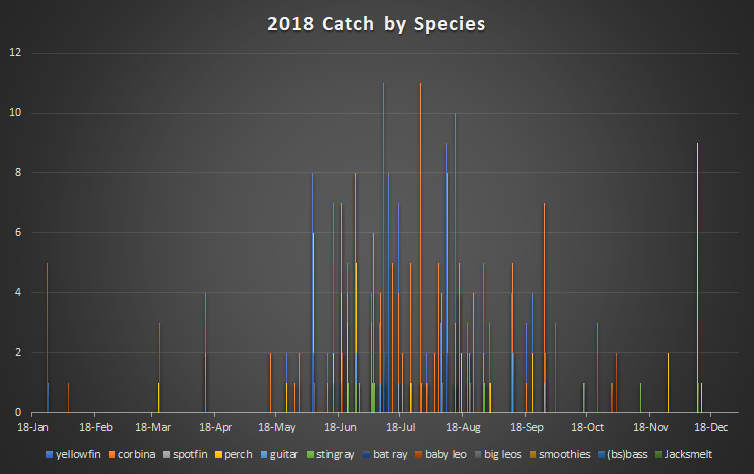

These next two charts (the first from 2018 and the second from 2019) show the same idea as the first. In these though, each session is stacked into one bar to make for easier differentiation of better overall days. We clearly see here that the first session in June was the beginning of peak Summertime surf fishing and the last good session was in the last few days of September. As for 2019, the first day of the season was May 14th for me while the last of the consistent good days was right around the last week of September even though I had a good day in November.
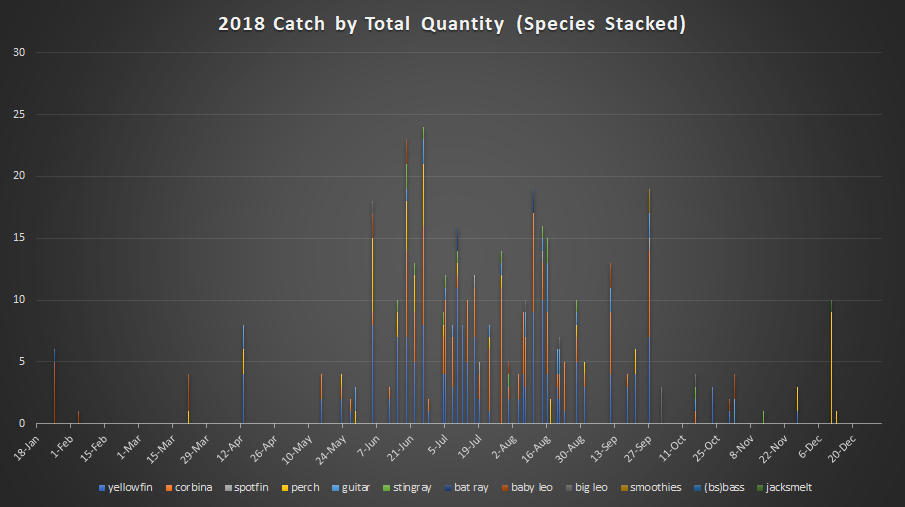

Best Time of Year for Yellowfin Croaker Fishing
Here, we see that in 2018, the best time of year for Yellowfin Croaker fishing began the first week of June and ended close to the end of September. In 2019, Yellows seemed to be biting as early as May and the summertime bite didn’t die down until the end of September. All in all, 2018 held many more Yellowfin Croaker than 2019.
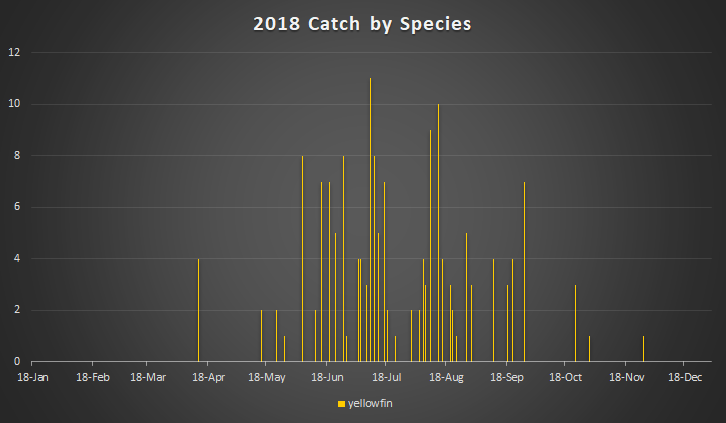
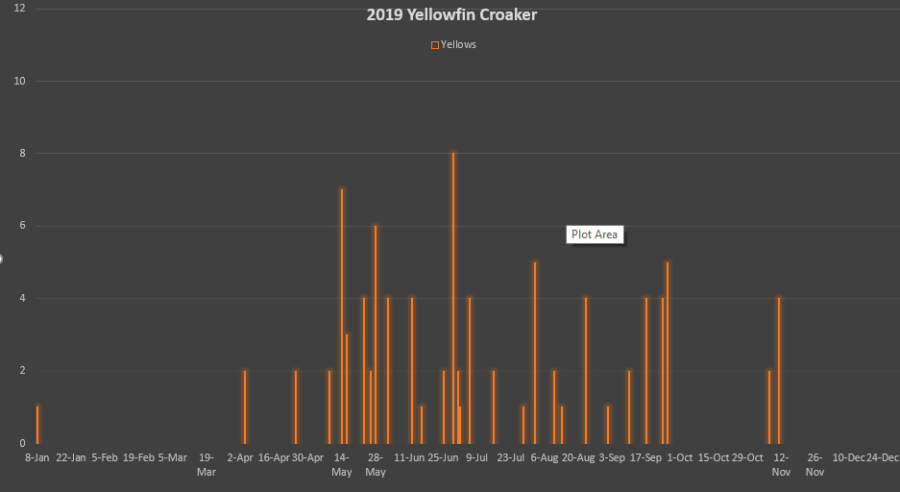
I also want to give you guys the opportunity to see what exactly I use (gear and tackle) to have the success that I have. Here’s my page outlining the exact gear and tackle that I like to use in the surf.
California Corbina Fishing: Best Time of Year
This chart shows that fishing for California Corbina didn’t pick up until mid-June and fizzled out as October rolled around. In 2019, a near-identical pattern in timing was presented. While I did not fish as much in 2019 as i did in 2018, the pattern is clearly similar. One very notable trend though, was that I caught many more Corbina then I did yellowfin Croaker. Similarly, I caught more Corbina than I ever have. The middle spike in the 2019 chart for Corbina represents a day in which I caught 21 Corbina in one session! That same day, my buddy caught somewhere around 25 Corbina!
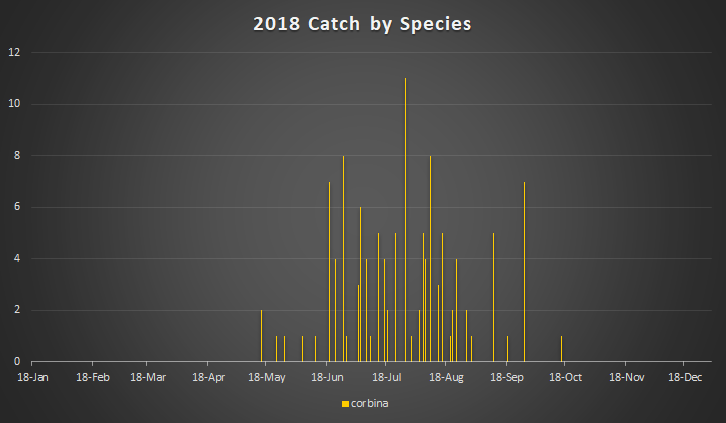

Overview of 2019
With all the data accounted for, here’s my take on this past year in comparison to 2018. Corbina were much more prevalent this season than last. Yellowfin Croaker, although not rare by any means, decreased in numbers for 2019. And, another (possibly more meaningful and interesting change was in the number of Adult leopard Sharks between 2018 and 2019. I caught 18 Leopard Sharks this past season (2019). That doesn’t even include the sharks that I got some of my buddies on or the sharks that my fishing partner caught. last year (2018), I only caught 7 leopard Sharks (over the length of 53 inches).
What made the difference? There are always a number of different variables involved in the change from yer to year in surf fishing. But, I believe the water temperatures made the biggest difference. In 2018, San Diego experienced record breaking temperatures in the City of La Jolla (and all around for that matter). In 2019, we had more regular water temperatures for the seasons staying in the low 70’s for the summertime (vs 80 degrees peak last summer).
Leopard Sharks and La Jolla
Why is this so important? Many of us are aware of the Leopard sharks that call La Jolla home within their migration patterns. In 2018, when we experienced record breaking temperatures, La Jolla (and all of San Diego) was not the only place these sharks could go to find warmer waters for their pups. So, rather than traveling to San Diego, I believe many sharks did not need to travel as far and settled for other locations that were warm enough for their preferences.
What this really means is that San Diego is naturally a unique place that Leopard Sharks are drawn to. It’s uniqueness is due to the nature of its relatively warm waters. The summer of 2018 was drastically warmer than previous summers and much warmer than the “average”. For this reason, many Marine Biologists and even locals might have predicted that San Diego (La Jolla) might draw in even more Leopard Sharks than usual. In reality, this was not the case. You could look at the findings in one of two ways… or both for that matter.
Theories
Option 1: The warmer waters affected all waters on the west coast thus, making San Diego and La Jolla much less unique. This might cause Leopard Sharks to remain content with warmer waters that don’t necessarily happen to be near San Diego.
Option 2: The record breaking temperatures were simply too much for Leopard Sharks and it pushed a large number of them away from San Diego. This theory, after feeling the water in peak summer months, holds merit in my opinion as at times, it was uncomfortably hot.
In my opinion, I would lean toward a combination of both theories in being the cause. I’ll let you decide for yourself . Whatever the reason may have been that these Leopards were less abundant in 2018 than in years past, it was refreshing to have them back in 2019.
Overall Take
Overall, both 2018 and 2019 were great years for surf fishing in San Diego! Additionally, the never-ending changes between seasons add to the excitement that makes surf fishing what it is! Either way, knowing the hows and whys help in understanding where and when to fish later down the road.
Keep in mind that the statistics presented here are solely representing my fishing activity over the past two years. While this can provide a very accurate representation of what fish are out there, and what fish are biting, it only truly shows what “I” tended to catch rather than what all fishermen across So Cal caught.
If you enjoy the content here in this article, be sure to enter your email in the box below and hit subscribe. You’ll receive an email every Sunday when the newest fishing report or informational article has been published.
[email-subscribers-form id=”1″]
If you have any thoughts, questions, or words of wisdom, please feel free to comment or reach out through the “contact us” page. Thanks and Happy New Year!
What beaches are best for surf fishing in San Diego? I went to South Mission beach this last Sunday and there was a lot of sea grass and a good surge. What is the time to go fishing? Thanks for your help! Silvester DeLuca 619-448-5936.
Refer to this: http://surffishingsocalsd.com/best-surf-fishing-spots-in-san-diego/
As for the times, I like sunset and sunrise but all day is good.